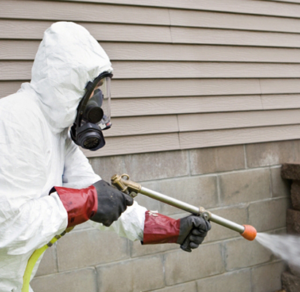Pest Control involves eliminating or managing unwanted organisms, such as insects and vertebrates. Some organisms are considered nuisance pests, such as pigeons, while others cause serious damage or disease, such as rodents and cockroaches.
Preventive steps include cleaning up cluttered areas to remove places where pests breed and hide, and fixing leaky plumbing. Other preventive actions include removing waste materials and using traps and bait stations. Click the https://pestcontrolkansascitypros.com/ to learn more.

Prevention is a key component of pest control, and it involves anticipating potential problems and taking steps to mitigate them before they become full-scale infestations. This might include sealing any cracks and openings around your home, keeping garbage cans tightly closed, and regularly cleaning and clearing out storage areas. It also means removing any debris or overgrown bushes from your property, as pests often nest in or crawl through them.
Threshold-based decision making refers to scouting and monitoring, and it allows you to identify when it’s time to take action. For example, a few wasps visiting your garden doesn’t warrant action, but if you see them flying into and out of the house repeatedly, it might be time to locate their nest. Preventive measures can help prevent costly damage and even disease, so it’s important to keep up with them.
In addition to prevention, you can use natural methods for pest control such as nematodes and parasitic fungus. These options don’t require any chemicals, so they’re more environmentally conscious than chemical treatments. But be aware that some biological methods may take longer to work, and they may only be effective for specific pests and environments.
For a more targeted approach, you can use pheromones, trap crops, and baits to lure pests and eliminate them. Some of these techniques involve chemicals, but they’re generally considered to be low risk and pose fewer risks than traditional pesticides. If you do decide to use a chemical product, be sure it’s the right type for your specific pest and environment, and always follow label instructions and safety warnings.
A comprehensive pest control plan should include a combination of these prevention and suppression tactics, as well as eradication when necessary. The right mix of tactics will vary depending on your unique situation and needs, so consult with a professional to develop an appropriate strategy. Just be sure to choose a company with a good track record, and one that prioritizes sustainable and ethical practices. The right pest control partner will ensure that your needs are met with minimal impact to your home, yard, or garden.
Suppression
Biological pest control uses natural enemies (predators, parasitoids, herbivores, pathogens, and competitors) to reduce the population size of target organisms. It requires an understanding of the biology of the pest and potential biological controls, as well as good management to ensure success. It is a key component of an Integrated Pest Management program. In its classic form, it involves importing or augmenting natural enemy organisms and releasing them in the field or greenhouse in small batches, as opposed to one large-scale release. This method can be successful in reducing the use of chemical pesticides.
Many disease-causing bacteria, fungi and protozoa can infect insect pests and disrupt their growth or reproduction. These pathogens are often sold as microbial insecticides, applied in much the same way as chemical pesticides. Pathogens can be used to manage a wide range of pests including insects, weeds and plant-parasitic nematodes.
Cultural practices are those that make the environment less suitable for pests by altering one or more of the environmental conditions they need to survive. Plowing, crop rotation, removal of infected plant material, cleaning greenhouse and tillage equipment and managing irrigation schedules can all be employed as cultural control methods.
Mechanical and physical controls are those that directly impact or physically manipulate pests and their habitats to limit the size of their populations. Traps, screens, barriers and fences can all be employed to limit or restrict pest access. Heat, radiation and electricity are also used to alter the environment of pests in order to kill or control them.
Regulatory control is the process of monitoring and evaluating pest problems, and taking action to prevent or eliminate them. This includes inspections, record keeping and reporting. It may also include the use of quarantines, eradication protocols, labelling, and other governmental regulatory actions.
The prevention of pests requires attention to details that are often overlooked. It might mean ensuring that firewood has been inspected for pests prior to transfer, or making sure to clean out attics or basements where pests like to hide. It might also involve careful assessment of the surrounding area for things that attract pests, such as a nearby compost pile or open trash bin that could attract rodents.
Eradication
Eradication is the permanent reduction to zero of the worldwide incidence of a disease as a result of deliberate intervention (smallpox, yellow fever, malaria). Unlike vaccination, eradication eliminates the microbe from the world and not simply from human populations. It requires certification that the disease no longer exists in any natural reservoir, and this is a very difficult task.
Pests are undesirable creatures that infest a building or environment. They often carry diseases that can affect humans and animals, and they damage property and crops. The types of pests that can infest homes and commercial properties include rodents, cockroaches, termites, fleas, bed bugs and other insects.
The goal of pest control is to keep the population of these creatures at a low level so that they do not pose a health or economic threat. Several techniques are used to achieve this, including prevention, suppression and eradication. Prevention methods involve preventing pests from entering a home or commercial building in the first place. These techniques may include sealing cracks in walls and around doors, cleaning food storage areas regularly and removing trash promptly. Pest-resistant plants are also helpful. Other preventive measures include installing screens over vents and fans in HVAC systems, using deterrent sprays and baits, and placing traps.
Suppression is the use of chemicals to kill or repel a specific pest species. Pesticides are a commonly used type of pest control, but they can be dangerous to humans and the environment if not handled properly. For example, if the wrong kind of chemical is used or it is applied too frequently, it can lead to resistance and even death.
Biological controls are another form of pest control that uses the natural enemies of a specific organism to keep its population at a manageable level. These natural enemies may include parasites, predators, pathogens or other organisms that naturally compete with or prey on the pest. Pheromones and juvenile hormones can also be used as biological controls.
Physical means of pest control are traps, netting and decoys. These methods require the involvement of a person to set the trap or handle the netting, but they are generally easier to use than chemical pest control solutions. These can include a variety of solutions such as repellents, which deter pests by masking their scent, or insecticides, which kill them.
Monitoring
Identifying pests is the first step in a successful pest control program. Correctly identifying pests helps you determine basic information about them, such as their life cycle and what kind of damage they can cause. This information can help you decide whether to tolerate them or if they require control. It also helps you select the most effective management methods and when to use them. This process, called monitoring, is an important part of integrated pest management (IPM).
Libraries and archives are vulnerable to many different kinds of pests. Some, termed continuous pests, are a constant threat and must be controlled regularly; others, like cockroaches and mice, may have a negative impact on collections but do not always need to be controlled. Other pests are sporadic and occasionally need to be managed; still others may only require control under certain circumstances, like the influx of migratory carpet beetles during warm weather.
Monitoring for pests can be accomplished by a variety of methods, including scouting and the use of sticky traps and insect pheromone monitors. Recording trap catches is critical, and the information collected should be used to identify problem areas and make adjustments in the IPM program.
Insect exclusion is another important control tactic, which can prevent pests from entering the building and damaging collections. This includes making sure doors used by staff and seldom-used fire escapes are tightly closed, sealing potential entry points on the outside of the building, using screens on windows and doors and caulking cracks around foundations. It is also important to maintain good housekeeping and vacuum susceptible exhibits, storage rooms, public areas and offices regularly.
Biological pest controls are the use of predators, parasites and natural enemies to reduce the population of a pest without killing it directly. Biological controls can be used to control almost any pest, and are particularly useful for preventing damage to rare or historic materials.








